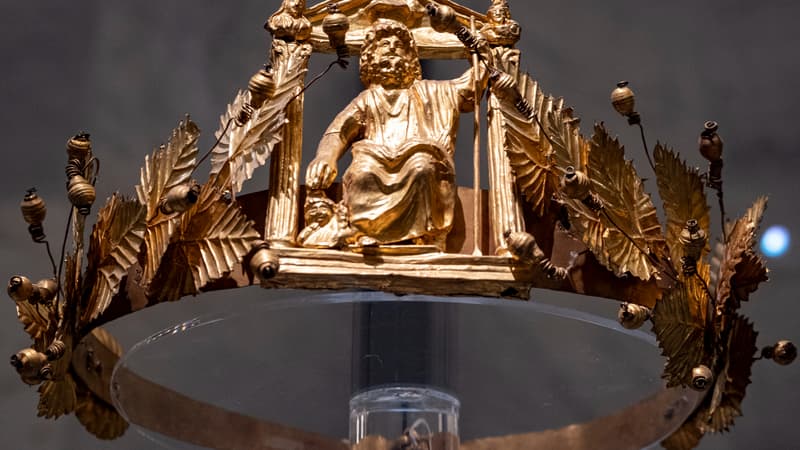It is an expression we see often. Gold is a “barbaric relic.” It is enough to type the two associated terms in Google to be convinced or take a look at the BFM Stock Exchange, where this same week the journalist used this periphrase of “barbarian relic” as an accepted synonym for gold. Although the precious metal breaks record after record and already exceeds $4,000 per ounce (a unit of measurement of 31 grams from, by the way, France), where does that expression “barbarian relic” come from?
The origin is quite easy to discover and is also well known to economics enthusiasts. It is taken from “A Tract on Monetary Reform”, an essay by the Englishman John Maynard Keynes published in 1924.
“In truth, the gold standard is already a barbaric relic,” in Colbert’s language.
Obviously, under his pen, the expression is very pejorative. The relic refers to an ancient thing, a fetish, an amulet. And the adjective “barbarian” refers to an uncivilized world. Seeing gold prices rise beyond reason, one might think that Keynes, who died almost 80 years ago, would not be kind to our times.
It was the gold standard, the “relic”
But nothing is less certain. Because in his text, the economist who gave name to the recovery policies through public spending does not criticize gold as such, but more precisely the gold standard, that is, the monetary system according to which the value of currencies was directly linked to a fixed amount of gold. Keynes held no grudge against gold as a metal that serves as a safe haven. What he considered absurd was the monetary system based on it.
To understand his mockery, a little historical reminder is necessary. Since ancient times, coins have had intrinsic value, usually a precious metal such as gold and silver. But when states began using paper money as banknotes, a crucial question arose: What is the value of this piece of paper? For citizens to trust a piece of paper, it had to represent a certain amount of gold or silver. The idea of the gold standard is, therefore, a promise of convertibility.
At the beginning of the industrial era, the gold standard regained strength with the multiplication of exchanges and the development of international trade. The United Kingdom adopted an official gold standard in 1821, followed by France and Germany. Little by little the so-called classical Gold Standard was established and at the end of the 19th century the entire industrial world adopted the gold standard. At that time, one pound sterling or one franc represented a fixed amount of gold. Which offers many advantages:
- Exchange rates are fixed between currencies as they are all pegged to gold.
- This facilitates international trade and investment.
- This encourages fiscal discipline because countries cannot print more money than they have gold to back it up.
- Finally, it potentially limits inflation because we can’t print more banknotes than we have in gold.
General de Gaulle, supporter of the standard
A value given to the gold standard that will mark the imagination for a long time. General de Gaulle, for example, at a press conference in 1965, declared his love for the “barbarian relic.”
The French head of state was greatly influenced by the economist Jacques Rueff, a great opponent of Keynes and a fervent supporter of gold.
But then why did Keyne abhor this gold standard that will eventually disappear in 1971 with the end of the Bretton Woods agreements? Because this system produced, in their eyes, its own economic diseases: deflation, unemployment and recession.
Specifically, under the gold standard, the amount of money in circulation depended on the amount of gold the country owned. So if a country lost gold (due to a trade deficit, for example), it would automatically have to reduce its money supply, lower wages, and reduce spending.
Second deficiency of the system: it prevented governments from acting. Paralyzing for the apostle of deficit recovery. For Keynes, a State should be able to use its monetary (and fiscal) policy to reactivate the economy. This is also the heart of his future work, The General Theory, published in 1936 between Roosevelt’s two “New Deals” in the United States.
socially unfair
Under the gold standard, this freedom did not exist. The Central Bank had to defend gold parity, not employment. It could not lower interest rates freely. A criticism that is made today of central banks when they favor the control of inflation over economic activity but that was much more prominent in the era of the gold standard.
As a reminder, Keynes destroyed the “barbaric relic” in 1924, at a time when the gold standard was being attempted to be reimposed after having been suspended ten years earlier to finance the 1914-18 war.
Final criticism of the English economist and no less important: maintaining a “strong” currency backed by gold mainly served bankers, rentiers and international investors since their assets were protected. On the other hand, this system was potentially harmful for employees (in case of loss of activity) or even for producers and investors who had restricted access to financing.
In short: socially unfair and economically absurd. For him, the gold standard “chained people to a useless metal” and belonged to an era in which economies were governed by the physical scarcity of the precious metal and not by the real needs of an economy dominated by growth.
In other words, a “barbaric relic.”
Source: BFM TV


